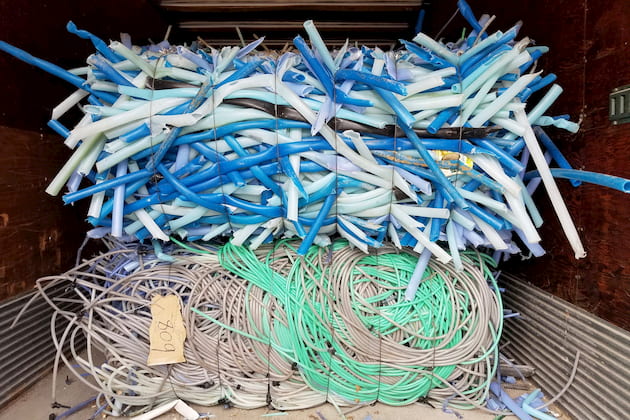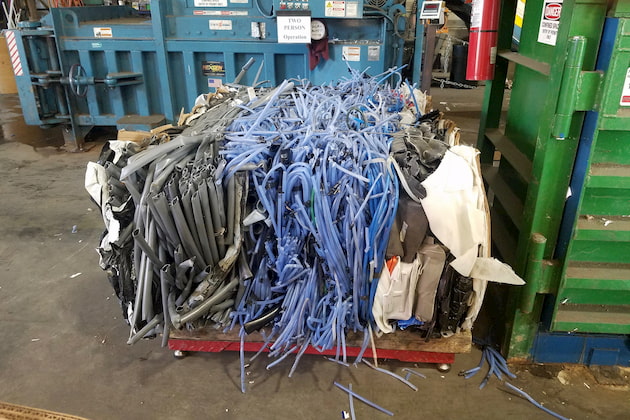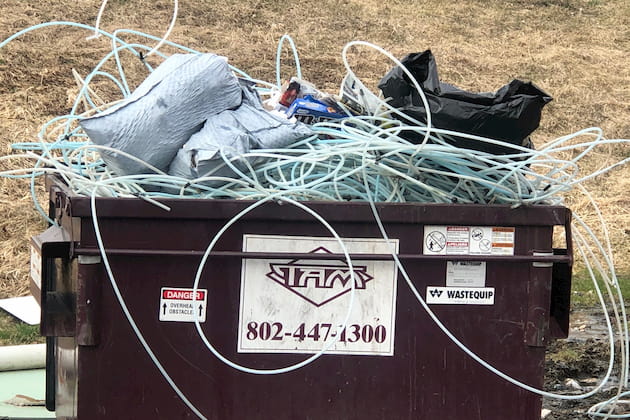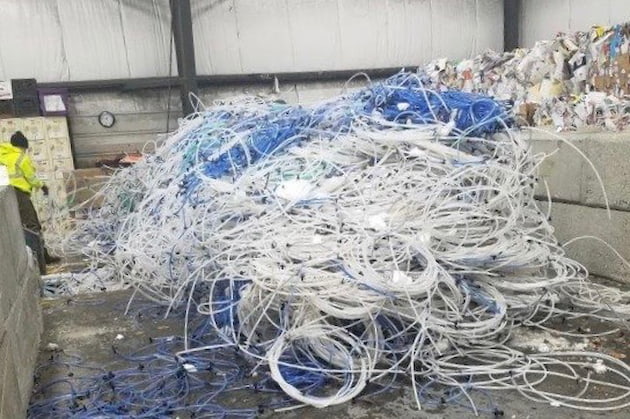Tapping & Tubing
Sapline and spout recycling program in Northern Vermont
Producers in other states can bring old tubing here too
By RICHARD BACKER, NORTHWEST VERMONT SOLID WASTE DISTRICT | MAY 26, 2020
GEORGIA, Vt.—Sugarmakers can recycle old tubing this spring instead of throwing it out with the trash.
The Northwest Vermont Solid Waste District (NWSWD) operates a small Material Recovery Facility (MRF) located at its administrative office adjacent to the Interstate 89 - Exit 18 interchange in Georgia, Vt.
The district is a municipally chartered organization fully serving 19 towns in Grand Isle and Franklin counties. NWSWD has an ongoing modest program to recover and recycle HDPE sapline.
Small and large syrup producers and county associations are encouraged to call NWSWD with inquiries or questions on recovery and recycling HDPE sapline.
Please call NWSWD at 802.524.5986.
If the sapline is clean, without contaminate plastics including spouts, tees or PVC we will take tubing from anyone in the state.
Sugarmakers in other states are welcome to bring their tubing to us as well, as long as it's clean.
NWSWD may also offer more limited service and support to residents of other communities that are members of chartered Vermont solid waste districts or like organizations.
NWSWD offers a fee-based program for recovering and recycling of specific agricultural related plastics. This article will focus on the District’s maple sapline recycling program.
Much of today’s maple syrup producers utilize a high-density polyethylene (HDPE) plastic tubing and pipeline to collect maple sap.
These collection networks of HDPE we see in Vermont forests are periodically removed from service and replaced with new lines.
HDPE is a readily recyclable plastic; however, downstream processors of recyclable materials generally establish material specifications or quality specifications for materials that will be processed into resources or raw materials used in the manufacturing process of new manufactured products.
The typical sugarbush HDPE tubing and mainline network is suspended in the sugarbush using tensile wire, wire ties and hose clamps.
Currently, these metal items must be removed from the HDPE materials before delivery to the NWSWD MRF for recovery and recycling. Metal items do not meet the quality standards for the downstream processor.
PVC plastic pipe is a non-HDPE contaminant plastic utilized in the sugarbush sapline collection system. PVC is a contaminant plastic and must be removed from the HDPE materials prior to delivery to the NWSWD MRF.
Other non-HDPE contaminant plastics utilized in the sugarbush sapline collection system include spouts, tees and connectors.
These items vary in material composition and may include polycarbonate spouts and nylon or other plastic connectors.
In the imperfect world of recovery and recycling, these materials would be removed prior to delivery to the MRF for recycling.
However, NWSWD recognizes this contaminant removal may be impractical for all producers and a pricing system exists to incentivize those who find it practical to clean the HDPE of all contaminant fittings.
NWSWD partners with a downstream processor that accepts a modest percentage of contaminant plastic connectors and spouts attached to the HDPE lines.
The District annually recovers and recycles approximately 30,000 pounds of sapline.
The sapline materials are compacted and baled and stored until onsite until the required shipping weight is reached. Sapline is received both in small and large quantities.
Small quantities are stored in boxes until enough material is available to compact and produce a bale; large quantities are tipped onto the receiving floor and baling begins immediately.
Currently, NWSWD ships sapline bales via intermodal transport: a box trailer moves from Georgia, Vermont via highway to Springfield, MA.
At the Springfield rail terminal, the trailer moves by train to Memphis, TN and from Memphis the load moves again over the road to Arkansas to the Delta Plastics manufacturing facility.
The Delta Plastics Stuttgart, AR facility processes the HDPE sapline into used plastic resins which are combined with virgin resins for the manufacture of agriculture dripline and other manufactured goods.
However, this reduced quality standard limits the annual tonnage the downstream processor will accept from NWSWD’s sapline recovery and recycling program.
Lastly, duct and electrical tapes are contaminant plastics that lower the HDPE quality standard.
SAPLINE RECOVERY/RECYCLING FEES
The District has established fees for recovering and recycling HDPE sapline
- HDPE sapline without contaminant plastics [spouts, tees, connections]
- cubic yard = $5.00
- HDPE sapline with contaminant plastics [spouts, tees, connections]
- cubic yard = $20.00
- Method of Payment: cash, check or invoice for large loads
NO FEE CUBIC YARD BOX EXCHANGE
The District offers the producer two options when delivering sapline to the MRF.
A producer may arrive and fill boxes at the time of delivery; a producer may receive boxes and pallets in advance at the Georgia MRF and then load boxes at the point of generation and then deliver full boxes MRF.
The producer must store boxes in dry conditions until delivery and have ability to load the pallet/box onto a trailer or pickup truck for unloading at the MRF.
For those producers at a greater distance to the MRF, the first delivery may include filling boxes at the MRF and then receiving empty, flat boxes as part of the exchange program.
PREPARING THE MATERIAL FOR THE CUBIC YARD BOX
Typical HDPE sapline may include “drops”, 5/16” line or mainline ranging from one-quarter inch to 4-inch diameter.
The “drops” and 5/16” line pack very well in the cubic yard box. Producers many times will coil the 5/16” line into manageable bundles and pack a box; uncoiled 5/16” line does not pack as well but will be accepted at the MRF.
The more rigid mainline materials must be cut into 30”- 36” lengths so the material will fit into the cubic yard boxes. The mainline should be cut to length prior to delivery to the MRF.
LARGE LOAD DELIVERY
By appointment, the District will receive large loads dumped directly to the receiving floor; these loads typically range from 20 to 30 cubic yards.
At this time, large loads are received at the MRF only on Friday with an advance appointment. Large loads do require more effort to process than managing cubic yard boxes, but some of the larger producers do use this opportunity.
SPOUT RECYCLING UPDATE
NWSWD is actively researching with plastic recycling processors in the Midwest any opportunities that can be identified to recycle plastic spouts. Initially the focus will be on analyzing polycarbonate spouts. We will offer an update later in the spring of 2020. Every spout typically has attached a small piece of HDPE sapline; this becomes a contaminant plastic when trying to recover and recycle the spout parent material.



































